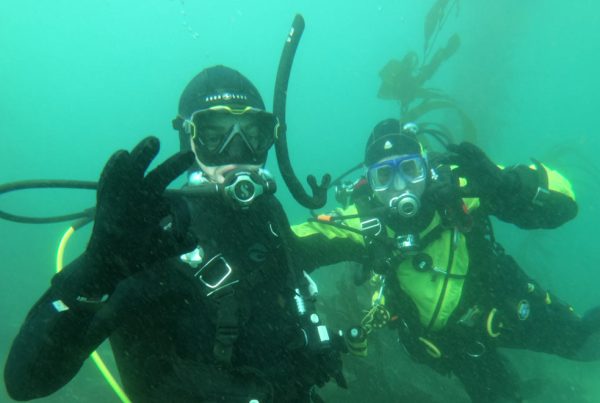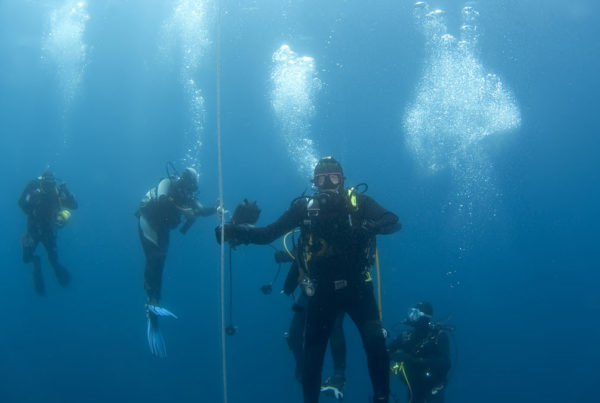Beach diving is a great way to fill out your diving itinerary. Scheduling is flexible, diving almost anytime you want (conditions permitting), as long as you want (air supply and bottom time allowing), and as often as you want. And it’s cheap. Beach diving is not much more difficult that boat diving, if you just make some proper preparations, actions on site, and cleanup after. The purpose of this article is to give you some tips on how to make your beach diving easier and, consequently, more fun.
PREPARATION AND PLANNING
Planning is important but you should be flexible. Along the California coastline there are sections where the beaches face in different directions. The Palos Verdes Peninsula is an example, as is Monterey. Because waves come in at different angles, choice of which direction a beach faces is critical in dealing with just how much surf you will encounter. In your planning, consider a primary destination as well as an alternate beach that faces in a different direction. For example, if you plan on diving the Redondo Canyon, a west-facing beach, a good alternative might be El Matador off Malibu, a protected south-facing beach. The night before your planned dive, check surf conditions and wave direction, either online or with a phone call (see contact information below) for planning. Then, if possible, check again just before you depart for your planned dive for a final destination decision.
Consider how you’ll be packing your gear. If you’ll be suiting up at your car, I recommend using a large plastic tub for all your gear except your tank and weight belt. Gear packing is easy (just throw it in) and the tub will also protect your automobile cargo compartment. Get one with wheels and it is easier to move gear from the vehicle to your rinse area. Rinsing is just a matter of filling the tub. A wheeled tub can also be used to transport gear to a dive site on the beach if an easy path is available. If you’ll be hiking gear down to the beach to dress in there, you’ll likely have to hoof your tank and weights on your back and waist and carry your gear in a traditional bag, wheeled or not.
Check your tank pressure the day before your planned dive. On the beach with your wetsuit on and buddies waiting is not the time to discover you have an empty tank.
There are a couple of ways of check-listing your gear to make sure you don’t forget anything. The foot-to-head technique lays out your gear just like that, the feet to the head. Then there is the “dress-in” technique where you pack your gear in the same order that you put it on. You could always use a written checklist. I use the head-to-foot but combined with always keeping all my gear in the same spot. Like an empty tank, you don’t want to discover you’re missing an important piece of gear when you are ready to go into the water.
There is some additional gear you need to consider. A ground mat is a good idea to limit sand and other dirt from getting on your gear and into the vehicle. A big bottle of water is also necessary. You use this for rinsing and, very important, hydrating your body. You will likely get a good workout beach diving, and you need to drink a fair amount of water both before and after the dive.
Vehicle key storage is important. With my SUV, I need only a key to get in but an electronic key to start the vehicle without triggering the alarm. I leave the electronic key in the vehicle and carry the regular key with me. I use a compact dry case hung around my neck to store the key along with important documents like a bit of cash, driver’s license, DAN card, and medical information.
ON SITE CONSIDERATIONS
Before putting any dive gear on, put yourself in a position to have a good look at dive site conditions. Give yourself at least 5 to 10 minutes to observe. What is the largest wave size you are likely to encounter? Waves tend to arrive in shore in “sets”—a group of large waves separated by an interval of smaller waves. These sets can be timed and then predicted with a fair amount of certainty—a set of three large waves followed by an interval of small waves of five minutes, for example. Make note of this timing for when you need to enter the water.
Look for rip currents, longshore currents, and rocks in the surf. Look for telltale signs of offshore reefs (kelp rising to the surface, wave distortions, etc.). Discuss the dive plan with your buddy as well as contingency plans. Familiarize yourself with other aspects of the site including pay phone location (in case of an emergency as it might be quicker to get to a pay phone than your cellular in your car), showers and restrooms.
If at all possible, suit in completely at your car except your fins and mask. Even defog your mask at your car using the water you brought. The less time you spend on the beach struggling with your gear, the better.










